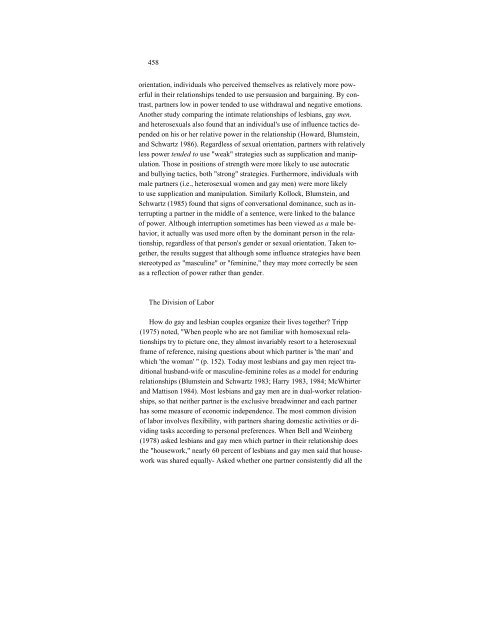17 The Close Relationships of Lesbians, Gay Men, and Bisexuals
17 The Close Relationships of Lesbians, Gay Men, and Bisexuals
17 The Close Relationships of Lesbians, Gay Men, and Bisexuals
You also want an ePaper? Increase the reach of your titles
YUMPU automatically turns print PDFs into web optimized ePapers that Google loves.
458<br />
orientation, individuals who perceived themselves as relatively more pow-<br />
erful in their relationships tended to use persuasion <strong>and</strong> bargaining. By con-<br />
trast, partners low in power tended to use withdrawal <strong>and</strong> negative emotions.<br />
Another study comparing the intimate relationships <strong>of</strong> lesbians, gay men,<br />
<strong>and</strong> heterosexuals also found that an individual's use <strong>of</strong> influence tactics de-<br />
pended on his or her relative power in the relationship (Howard, Blumstein,<br />
<strong>and</strong> Schwartz 1986). Regardless <strong>of</strong> sexual orientation, partners with relatively<br />
less power tended to use "weak" strategies such as supplication <strong>and</strong> manip-<br />
ulation. Those in positions <strong>of</strong> strength were more likely to use autocratic<br />
<strong>and</strong> bullying tactics, both "strong" strategies. Furthermore, individuals with<br />
male partners (i.e., heterosexual women <strong>and</strong> gay men) were more likely<br />
to use supplication <strong>and</strong> manipulation. Similarly Kollock, Blumstein, <strong>and</strong><br />
Schwartz (1985) found that signs <strong>of</strong> conversational dominance, such as in-<br />
terrupting a partner in the middle <strong>of</strong> a sentence, were linked to the balance<br />
<strong>of</strong> power. Although interruption sometimes has been viewed as a male be-<br />
havior, it actually was used more <strong>of</strong>ten by the dominant person in the rela-<br />
tionship, regardless <strong>of</strong> that person's gender or sexual orientation. Taken to-<br />
gether, the results suggest that although some influence strategies have been<br />
stereotyped as "masculine" or "feminine," they may more correctly be seen<br />
as a reflection <strong>of</strong> power rather than gender.<br />
<strong>The</strong> Division <strong>of</strong> Labor<br />
How do gay <strong>and</strong> lesbian couples organize their lives together? Tripp<br />
(1975) noted, "When people who are not familiar with homosexual rela-<br />
tionships try to picture one, they almost invariably resort to a heterosexual<br />
frame <strong>of</strong> reference, raising questions about which partner is 'the man' <strong>and</strong><br />
which 'the woman' " (p. 152). Today most lesbians <strong>and</strong> gay men reject tra-<br />
ditional husb<strong>and</strong>-wife or masculine-feminine roles as a model for enduring<br />
relationships (Blumstein <strong>and</strong> Schwartz 1983; Harry 1983, 1984; McWhirter<br />
<strong>and</strong> Mattison 1984). Most lesbians <strong>and</strong> gay men are in dual-worker relation-<br />
ships, so that neither partner is the exclusive breadwinner <strong>and</strong> each partner<br />
has some measure <strong>of</strong> economic independence. <strong>The</strong> most common division<br />
<strong>of</strong> labor involves flexibility, with partners sharing domestic activities or di-<br />
viding tasks according to personal preferences. When Bell <strong>and</strong> Weinberg<br />
(1978) asked lesbians <strong>and</strong> gay men which partner in their relationship does<br />
the "housework," nearly 60 percent <strong>of</strong> lesbians <strong>and</strong> gay men said that house-<br />
work was shared equally- Asked whether one partner consistently did all the
















